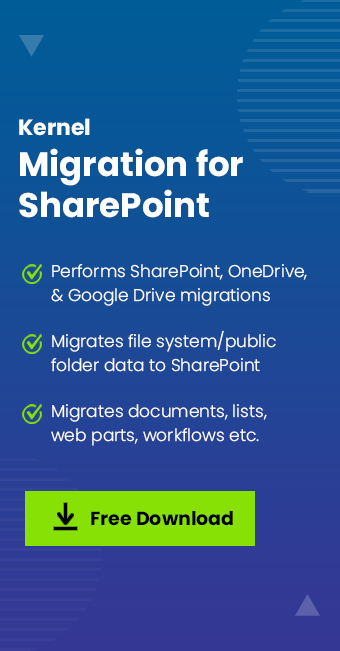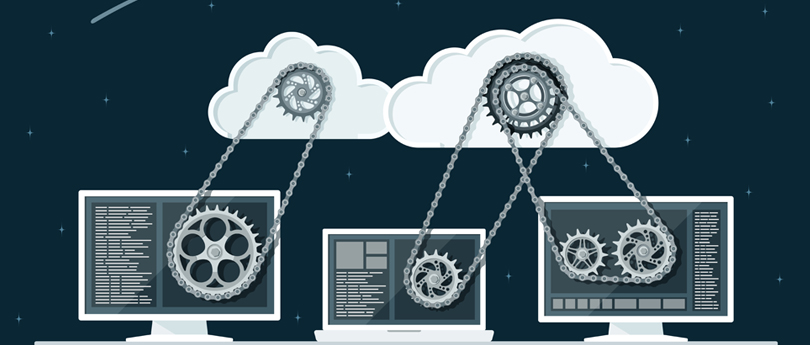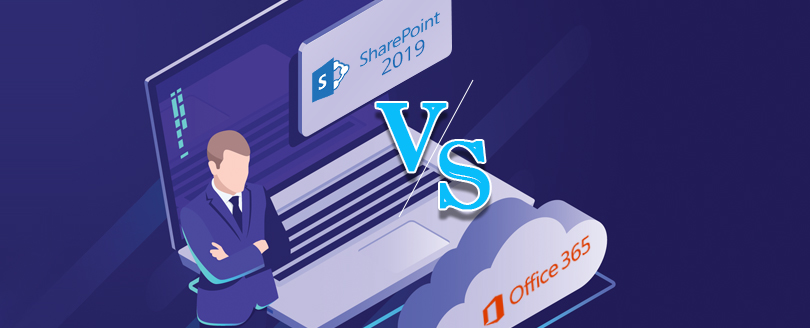Read time: 5 minutes
Proper planning and strategizing are the keys to achieving an error-free migration of data to Microsoft 365. There are several factors that you must consider while transitioning from a SharePoint server deployed on-premises to the one hosted online (i.e. cloud-based Office 365). Apart from encountering some of the common issues like improper planning, out-of-place processes, poor compatibility, rising costs, and zero flexibility, you need to watch out for the following 4 things to establish if your enterprise is actually ready for migration. All these are some of the “rarely covered” yet “important to address” migration considerations that you may forget to take into account when you migrate SharePoint content to Office 365
Why Migrate SharePoint Content to Office 365?
There are several reasons too that compel users to migrate SharePoint content to Microsoft 365. Let’s have a look at some of those reasons:
- Unlike SharePoint versions that come with end-of-life, Office 365, being a cloud-based service, is regularly updated. New features and security updates are introduced into it on a regular basis, which means you have access to an updated platform as long as your license is activated.
- Microsoft 365 comes with a suite of applications like Exchange Online, OneDrive, etc. Buying one license can provide you access to multiple applications.
- Office 365 does not require installing any infrastructure or servers to manage data, which otherwise is needed while working with SharePoint on-premises. It eliminates the expenses that you need to spend on resources for managing the on-premises arrangement.
What you Need to Know During SharePoint to Office 365 Migration?
Migrating SharePoint to Microsoft 365 can be a complex process that involves numerous difficulties. However, with careful planning and execution, it doesn’t have to be a nightmare. In this article, we will discuss four effective methods for migrating SharePoint to Office 365 to help you navigate this process successfully.
1. Plan the Whole Migration Journey
Legacy SharePoint systems that many companies are still relying on demand comprehensive customization. It’s not always easy to ensure that all those customizations work the same way after moving to the cloud. Hence, for smooth migration, you need to plan the migration of your content properly. Create a schedule and SharePoint migration checklist that clearly defines when to migrate, what to migrate, and how to migrate.
When creating the strategy to migrate SharePoint, it is better to decide which tool or medium you will be using for the complex data transfer. The most popular options when it comes to migrating SharePoint data from on-premises to Office 365 is the SPMT (SharePoint Migration Tool).
Hence, to make this transitioning much easier and quicker, several third-party tools are available, like “Kernel Migrator for SharePoint,” that facilitates migration from on-premises file servers and SharePoint to Office 365. Besides this, tools allow you to avail benefits of additional features like migrating metadata along with permissions, mapping file attributes automatically, and generating CSVs for bulk migration of content.
2. Auditing the Current Data is Important
When it comes to the cloud, determining the state of your current SharePoint content is extremely necessary even before you plan to start migrating your files & documents. Structuring everything in the right way before proceeding to migrate is the key to flawless and smooth transitioning. Audit your content for validity and archive old files & folders that are not required in your new virtual set-up (i.e., on the cloud). Moreover, auditing custom functionalities like templates, workflows, etc., that exist in your current SharePoint system is important to understand whether it would be possible to integrate them when you switch to the cloud.
Investigate a new way of reworking information architecture if you want to automate your migration process. Not just this, you may want to carry out a Pre-Migration checkup of the entire system using third party tools. To simplify your job, use a 3rd party SharePoint Migration tool that can pre-check for any issues that may come your way during migration and fix them before moving the actual content.
3. Keep in Mind the Post-Migration Changes
The Office 365 (SharePoint Online) can do most things, but it is still a software. To make sure you can continue with SharePoint Online for the long term without any issues post-migration, monitoring and maintenance are essential. You should continuously track the platform’s health and performance through Microsoft 365 admin centers and other tools.
Additionally, you must learn about the security features of Office 365, like DLP (Data Loss Prevention), and how you can implement those to protect your data after SharePoint migration. Furthermore, you will have to provide training about the SharePoint Online and Office 365 features. This is necessary to eliminate any confusion &human error to maximize productivity.
4. Cloud Does Things Differently
When you move your SharePoint from your own servers to Office 365 (which is in the cloud), it’s not enough to just move your files. The cloud works differently, so you need new rules for how you handle your information. You need to consider these things before migration:
How to manage your files: Office 365 uses Microsoft Purview to manage data and retention policies. You need to adapt to this modern way of doing things, like archiving, sharing, deleting, and other data-related activities in SharePoint Online.
Access level: Depending upon how permissions and file access work in Office 365, you need to set new access rights to decide who can see what. Make clear rules for sharing data within the organization or outside your company.
Optimize storage to keep costs down: Understand how much storage you get with your license and what it will cost to own extra storage. Cloud storage is scalable. You can have as much storage as you want, but it’s not free.
Migrate SharePoint Content to Office 365 – Best Practices
By following these practices, you can easily migrate content from SharePoint on-premises to SharePoint Online (Microsoft 365):
- Separate the data from unnecessary files and folders so that you are taking only the valuable data in the destination rather than migrating the whole data.
- Make sure to take complete backups of data regularly so that you can avoid any possible data loss.
- Use a professional SharePoint to SharePoint Online migration tool to move the data to the cloud.
- Make sure there is enough space at the destination to accommodate the data you are migrating.
- Configure the destination server with higher resources than your current environment for future scalability.
- Test the new environment before you migrate SharePoint content to Office 365 to avoid any post-migration issues.
Final Words
Majority of organizations are looking to migrate SharePoint content to Office 365 (SharePoint Online) to access the advanced features and efficiency that it offers. To simplify the process of SharePoint to Office 365 migration, it’s suggested to utilize an advanced third-party tool like Kernel Migration for SharePoint that helps to simplify the process of SharePoint data migration.








